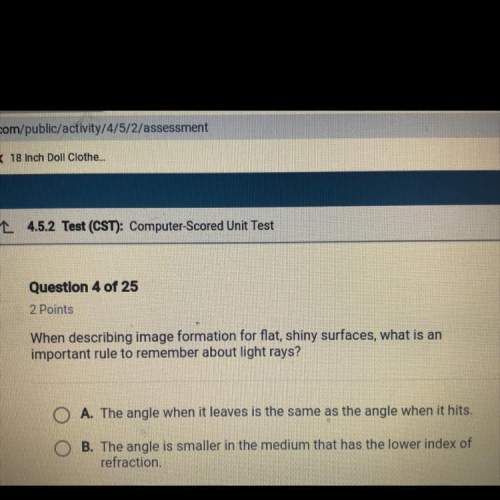
Physics, 12.07.2019 03:20, emmilicious
Arectangular tank is 4 ft by 5 ft with height 2 ft. if the tank is filled with water weighing 62.4 pounds per cubic foot, how much work w is required to empty the tank?

Answers: 1
Other questions on the subject: Physics

Physics, 21.06.2019 20:20, jacesmokesloud7254
Copper has free electrons per cubic meter. a 71.0-cm length of 12-gauge copper wire that is 2.05 mm in diameter carries 4.85 a of current. (a) how much time does it take for an electron to travel the length of the wire? (b) repeat part (a) for 6-gauge copper wire (diameter 4.12 mm) of the same length that carries the same current. (c) generally speaking, how does changing the diameter of a wire that carries a given amount of current affect the drift velocity of the electrons in the wire?
Answers: 2

Physics, 21.06.2019 22:30, mirellaenriquez5529
Follow these directions and answer the questions. 1. shine a pencil-thin beam of light on a mirror perpendicular to its surface. (if you don't have a laser light as suggested in the video, you can make a narrow beam from a flashlight by making a cone from black construction paper and taping it over the face of the flashlight.) how does the light reflect? how does the relationship of incident to reflected ray relate to the reflection of water waves moving perpendicular to a barrier? 2. shine a pencil-thin beam of light on a mirror standing on a sheet of paper on the table (or floor) so that you can mark the incident ray and reflected ray. (you can support the mirror from the back by taping it to a wooden block.) 3. mark a line on the paper representing the reflective surface. (the reflective surface of a mirror is usually the back edge.) 4. draw a dashed line perpendicular to the mirror surface at a point where the incident and reflected ray meet. this perpendicular is called a normal to the surface. 5. measure the angles between the rays and the normal. the angle of incidence is the angle formed by the incident ray and the normal to the surface. the angle formed by the reflected ray and normal is called the angle of reflection (r). what is the angle of incidence? what is the angle of reflection? 6. repeat for several different angles. (see report sheet for details.) what appears to be the relationship between the angle of incidence and angle of reflection? in science 1204, what was the relationship for these two angles made by the reflection of waves in a ripple tank? 7. roll a ball bearing so that it hits a fixed, hard surface (a metal plate) at several angles (including head-on). observe the way in which the ball bearing reflects. what generalization can you make about how a ball bearing reflects from a wall? have you proved that light can only behave like a wave?
Answers: 1

Physics, 22.06.2019 01:30, Savageman4654
The transfer of heat through the movement of a gas or liquid a. convection b. conduction c. radiation
Answers: 2
Do you know the correct answer?
Arectangular tank is 4 ft by 5 ft with height 2 ft. if the tank is filled with water weighing 62.4 p...
Questions in other subjects:

History, 01.08.2019 00:30


English, 01.08.2019 00:30

Mathematics, 01.08.2019 00:30

Biology, 01.08.2019 00:30

History, 01.08.2019 00:30


Social Studies, 01.08.2019 00:30








